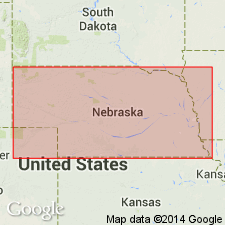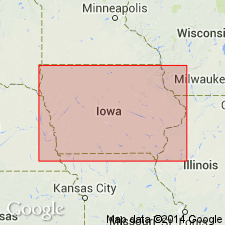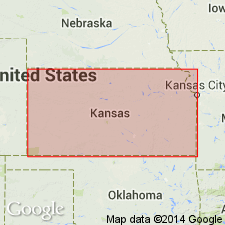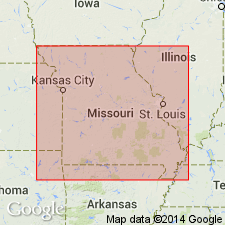
- Usage in publication:
-
- Beil limestone bed
- Modifications:
-
- Original reference
- Dominant lithology:
-
- Limestone
- AAPG geologic province:
-
- Nemaha anticline
Summary:
Pg. 48. Beil limestone bed of Lecompton limestone member of Shawnee group. Beil limestone (not the Cullom), underlies King Hill shale and overlies Queen Hill shale in Jones' Point to Sand Point section. Is in 2 beds separated by shale with fossils typical of the unit. Thickness 4 feet 8 inches to 5 feet. Occurs in southeastern Nebraska. Age is Pennsylvanian.
[Origin of name not stated.]
Source: US geologic names lexicon (USGS Bull. 896, p. 148); GNC KS-NE Pennsylvanian Corr. Chart, sheet 1, Oct. 1936; supplemental information from GNU records (USGS DDS-6; Denver GNULEX).

- Usage in publication:
-
- Beil limestone member
- Modifications:
-
- Principal reference
- AAPG geologic province:
-
- Nemaha anticline
Summary:
Pg. 176. Beil limestone member of Lecompton limestone of Shawnee group. Type locality of Beil limestone is Beil farm, on Missouri River bluffs near mouth of Kenosha Valley, 2 miles south and 1 mile east of Rock Bluff, Cass County, Nebraska. Name derived from Beil farm. Age is Late Pennsylvanian (Virgil).
Source: US geologic names lexicons (USGS Bull. 896, p. 148; USGS Bull. 1200, p. 279); GNC KS-NE Pennsylvanian Corr. Chart, sheet 2, Oct. 1936.

- Usage in publication:
-
- Beil limestone member
- Modifications:
-
- Revised
Summary:
Pg. 23-24. [Revised to] Beil limestone member of Lecompton limestone. Consists of two limestone separated by shale. Thickness 3 to 6 feet in Nebraska and 4 to 12 feet in Kansas. Underlies King Hill shale member; overlies Queen Hill shale member.
See also R.C. Moore and others, 1951, Kansas Geol. Survey Bull. 89, p. 66.
Source: US geologic names lexicon (USGS Bull. 1200, p. 279).

- Usage in publication:
-
- Beil limestone member
- Modifications:
-
- Areal extent
Summary:
Pg. 19, fig. 5. Beil limestone member of Lecompton limestone. Consists of two limestones separated by shale. Upper limestone light-gray, dense, massive, with abundant OSAGIA. Shale is buff and calcareous, grading into limestones above and below, and carries profusion of coral CAMPOPHYLLUM TORQUIM. Lower limestone fossiliferous and argillaceous. Thickness 3 to 6 feet. Underlies King Hill shale member; overlies Queen Hill shale member. Age is Late Pennsylvanian (Virgilian).
Source: US geologic names lexicon (USGS Bull. 1200, p. 279).

- Usage in publication:
-
- Beil Limestone Member
- Modifications:
-
- Overview
Summary:
(Paleozoic Era; Pennsylvanian System by J.M Jewett, H.G. O'Connor, and D.E. Zeller, p. 37.) Beil Limestone Member of Lecompton Limestone of Shawnee Group. In Kansas, consists of thin- to medium-bedded, abundantly fossiliferous, bluish-gray limestone averaging 8 to 10 feet, but ranging from 4 to 15 feet in thickness. In northern outcrops the upper part includes interbedded calcareous shale and thin limestones, whereas in southern outcrops the member is more massive and contains fewer shaly beds. Fossils are very abundant, especially horn corals, bryozoans, and fusulinids. Occurs above Queen Hill Shale Member and below King Hill Shale Member, both of Lecompton Formation. Age is Late Pennsylvanian (Virgilian).
Source: Publication.

- Usage in publication:
-
- Beil Limestone Member
- Modifications:
-
- Overview
Summary:
Pg. 123 (fig. 36), 124. Beil Limestone Member of Lecompton Formation of Shawnee Group. Recognized in northwestern Missouri. Composed of several layers of fossiliferous limestone interbedded with calcareous shale. Thickness 4 to 5 feet. Shown on stratigraphic section overlying Queen Hill Shale Member and underlying King Hill Shale Member, both of Lecompton Formation. Age is Late Pennsylvanian (Virgilian).
Source: Publication.
For more information, please contact Nancy Stamm, Geologic Names Committee Secretary.
Asterisk (*) indicates published by U.S. Geological Survey authors.
"No current usage" (†) implies that a name has been abandoned or has fallen into disuse. Former usage and, if known, replacement name given in parentheses ( ).
Slash (/) indicates name conflicts with nomenclatural guidelines (CSN, 1933; ACSN, 1961, 1970; NACSN, 1983, 2005, 2021). May be explained within brackets ([ ]).

